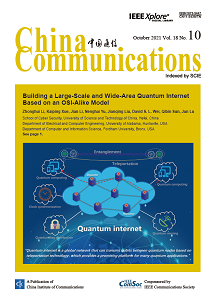蜂窝集成通信和传感服务的体系结构
IF 3.1
3区 计算机科学
Q2 TELECOMMUNICATIONS
引用次数: 1
摘要
通过引入传感功能来扩展5G+/6G网络功能的集成传感和通信(ISAC)越来越受到关注。虽然基于现有5G物理层设计,单静态或双静态ISAC解决方案已经显示出可行性和效益,但是否以及如何协调多个ISAC设备以更好地发挥网络性能却很少被讨论。第三合作伙伴计划(3GPP)已经启动了ISAC用例研究,后续的网络架构研究可以预期。在本文中,我们重点研究了基于gnb的感知模式,并提出了ISAC功能框架和给定的高级服务程序,以实现基于蜂窝的ISAC服务。在提出的ISAC框架中,通过与网络节点的交互,设计了三种用于感知业务的网络功能,即感知功能(sensing Function, SF)、轻量级边缘感知功能(lightweight-Edge sensing Function, ESF)和全版本边缘感知功能(full-version-ESF),以满足ISAC用例的延迟需求。最后,通过仿真评估和硬件试验台结果,我们进一步验证了ISAC在基于gnb的5G感知模式下的性能优势和可行性,该模式采用新设计的SF和相关信令协议。本文章由计算机程序翻译,如有差异,请以英文原文为准。
Architecture for cellular enabled integrated communication and sensing services
There is growing interest in the integrated sensing and communication (ISAC) to extend the 5G+/6G network capabilities by introducing sensing capability. While the solutions for mono-static or bi-static ISAC have shown feasibility and benefits based on existing 5G physical layer design, whether and how to coordinate multiple ISAC devices to better exert networking performance are rarely discussed. 3 rd Partnership Project (3GPP) has initiated the ISAC use cases study, and the follow-up studies for network architecture could be anticipated. In this article, we focus on gNB-based sensing mode and propose ISAC functional framework with given of highlevel service procedures to enable cellular based ISAC services. In the proposed ISAC framework, three types of network functions for sensing service as Sensing Function (SF), lightweight-Edge Sensing Function (ESF) and full-version-ESF are designed with interaction with network nodes to fulfill the latency requirements of ISAC use cases. Finally, with simulation evaluations and hardware testbed results, we further verify the performance benefit and feasibility to enable ISAC in 5G for the gNB-based sensing mode with new design on SF and related signaling protocols.
求助全文
通过发布文献求助,成功后即可免费获取论文全文。
去求助
来源期刊

China Communications
工程技术-电信学
CiteScore
8.00
自引率
12.20%
发文量
2868
审稿时长
8.6 months
期刊介绍:
China Communications (ISSN 1673-5447) is an English-language monthly journal cosponsored by the China Institute of Communications (CIC) and IEEE Communications Society (IEEE ComSoc). It is aimed at readers in industry, universities, research and development organizations, and government agencies in the field of Information and Communications Technologies (ICTs) worldwide.
The journal's main objective is to promote academic exchange in the ICTs sector and publish high-quality papers to contribute to the global ICTs industry. It provides instant access to the latest articles and papers, presenting leading-edge research achievements, tutorial overviews, and descriptions of significant practical applications of technology.
China Communications has been indexed in SCIE (Science Citation Index-Expanded) since January 2007. Additionally, all articles have been available in the IEEE Xplore digital library since January 2013.
 求助内容:
求助内容: 应助结果提醒方式:
应助结果提醒方式:


